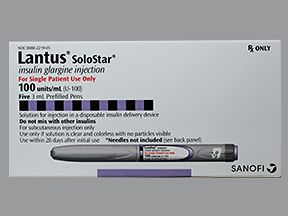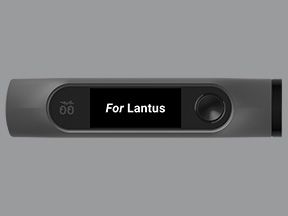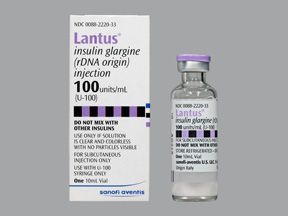Lantus (insulin glargine) is a brand-name drug that’s prescribed to improve blood sugar levels in certain people. Lantus is an injection that’s administered under the skin. Dosages can vary depending on what condition the drug is prescribed to help treat.
Lantus is prescribed to help improve blood sugar levels in:
- adults with type 2 diabetes
- adults and children ages 6 years and older with type 1 diabetes
Lantus is a biologic and belongs to a drug class called long-acting insulins. Lantus is available in a biosimilar version.
Keep reading for specific information about the dosage of Lantus, including its strength and how to use the medication. For a comprehensive look at Lantus, see this article.
Note: This article describes typical dosages for Lantus provided by the drug’s manufacturer. When using Lantus, always follow the dosage prescribed by your doctor.
Below is information about Lantus dosages for its approved uses.
Lantus forms
Lantus is available in two forms. One is a multidose vial that you use with syringes and needles. The other is a prefilled SoloStar pen that you use with a pen needle.
Both forms are given as subcutaneous injections. (How a drug is given is known as its route of administration.) Your doctor will help determine which form is best for you.
Lantus strengths
Both the Lantus multidose vial and the prefilled SoloStar pen come in one strength: 100 units of insulin glargine per 10 milliliters (mL) of liquid solution. This strength is abbreviated as U-100.
Typical dosages
Your doctor will typically start you on a low dosage of Lantus. Then, they’ll adjust your Lantus dose over time to reach the amount that’s right for you. Your doctor will ultimately prescribe the smallest dosage that provides the desired effect.
The following information describes dosages that are commonly used or recommended. However, be sure to follow the dosage your doctor prescribes for you. Your doctor will determine the best dosage to fit your needs. Keep in mind that there’s no average Lantus dose.
Note: Doctors do not typically prescribe Lantus to treat diabetic ketoacidosis, which is a rare but serious potential complication of diabetes.
Dosage for type 1 diabetes
For type 1 diabetes, your starting dose of Lantus is usually about one-third of your total daily insulin dose. (The rest of your total daily insulin dose typically consists of short-acting mealtime insulin.)
Your total daily insulin dose is based on your body weight in kilograms (kg). A kg equals about 2.2 pounds (lb). Your dosage may range from 0.4 units/kg to 1 unit/kg per day.
Below is an example of a Lantus dosage chart for type 1 diabetes:
| Body weight | Possible prescribed daily insulin dosage | Total daily insulin dose | Starting daily dose of Lantus |
| 80 kg (about 175 lb) | 0.6 units/kg | 48 units | 16 units |
Your doctor will determine what your Lantus dosage should be. You’ll use Lantus once per day.
Dosage for type 2 diabetes
For people with type 2 diabetes who aren’t currently taking insulin, the recommended starting dosage of Lantus is 0.2 units/kg or 10 units once per day.
The maximum starting dosage of Lantus is 10 units per day.
If you have type 2 diabetes and are switching from a different insulin, your doctor will prescribe the dosage that’s best for you. They’ll consider the type and amount of insulin you used to decide your dosage of Lantus.
Dosages using vials vs. prefilled SoloStar pens
There’s no difference in dosage based on the form of Lantus you use. Dosages using vials and prefilled SoloStar pens are the same.
Children’s dosage
Lantus is approved to improve blood sugar levels in children ages 6 years and older with type 1 diabetes.
The children’s dosage of Lantus is the same as the dosage for adults. For details, see “Dosage for type 1 diabetes” above.
Long-term use
Lantus is typically used as a long-term treatment. If you and your doctor determine that Lantus is safe and effective for you, you’ll likely use it long term.
Below are answers to some frequently asked questions about Lantus dosages.
What are the starting and maximum doses of Lantus?
There aren’t starting and maximum dosages of Lantus that apply to everyone.
The starting dose of Lantus that your doctor prescribes is based on whether or not you take insulin and how much you take. The dose may also depend on how much you weigh.
Your doctor will use your blood sugar levels and other tests to adjust your dosage of Lantus until they find what works best for you.
There’s no standard or maximum dosage of Lantus. Instead, your doctor will prescribe a dosage of Lantus that’s based on your individual needs. You should not use more Lantus than your doctor prescribes.
For more information on dosages of Lantus, see the rest of this article. You can also talk with your doctor or pharmacist.
Is there a calculator for Lantus dosing?
There’s a calculator for Lantus dosing available to your doctor. It can help them determine the right dose of Lantus for you.
For more information on dosages of Lantus, see the “Lantus dosage” section above. You can also talk with your doctor or pharmacist.
Does Lantus have specific dosages for bedtime?
No, there aren’t specific dosages of Lantus for bedtime. Lantus is typically injected once daily, at any time of day. However, it’s best to inject your dose at the same time every day. This helps keep a steady level of Lantus in your system so that it can work effectively.
Be sure to use the dosage of Lantus your doctor prescribes for you.
If you have additional questions about the timing of your Lantus dose, talk with your doctor or pharmacist.
Would my doctor recommend splitting my Lantus doses?
Maybe. Your doctor may recommend splitting your Lantus dose if your blood sugar levels start to increase shortly before your next dose is due. (Splitting a dose means dividing a once-daily dose into two or more doses throughout the day.)
Dosing twice a day with Lantus is not a dosage that’s approved by the FDA. However, your doctor may recommend it off-label. (Off-label use is when a doctor prescribes a drug differently than how the FDA approved it.)
If you have additional questions about your Lantus dose, including off-label dosing, talk with your doctor or pharmacist.
If you miss a dose of Lantus, administer it as soon as you remember. However, if it’s the next day or almost time for your next dose, skip the missed dose and administer your next dose at the regular time. You should not use more than one dose at once or double your dose of Lantus to “make up” for the missed dose.
The Lantus dosage your doctor prescribes will depend on several factors. These include:
- the type and severity of the condition you’re using Lantus to treat
- your weight
- your blood sugar level goals
- how your blood sugar levels respond to treatment
Other medical conditions you have may also affect your Lantus dosage. Talk with your doctor about the dose of Lantus that’s right for you.
Dosage adjustments
Your doctor may increase your Lantus dosage based on your blood sugar levels and other test results. They may also adjust your dose based on other factors, including:
- changes in your physical activity
- changes in your meals or eating habits
- changes to your health, such as when you have an infection
- changes to how well your liver or kidneys work
If you have liver or kidney problems, your doctor may talk with you about adjusting your Lantus dose. This may involve decreasing or increasing your dose of Lantus.
Your doctor will ultimately prescribe the smallest dosage that provides the desired effect.
Lantus is available in two forms: a multidose vial and a prefilled SoloStar pen.
Both forms are given as subcutaneous injections. Your doctor will help determine which form is best for you. They or another healthcare professional can also teach you how to self-inject Lantus.
Where to inject Lantus
You’ll inject Lantus into one of the following areas:
- your upper arms
- your abdomen, at least 2 inches away from your belly button
- your thighs
You should vary the site where you inject each dose of Lantus. This helps reduce your risk of certain side effects, such as pits or lumps in your skin.
Keep in mind that you should not inject Lantus into areas of your skin that have thickened or that have pits or lumps. Also, do not inject the drug into areas of skin that are scarred, damaged, bruised, tender, scaly, or hard.
You can visit the manufacturer’s website for step-by-step instructions on how to use Lantus multidose vials or prefilled SoloStar pens.
To help make sure that you don’t miss a dose, try using a medication reminder. This can include setting an alarm or using a timer. You could also download a reminder app on your phone.
Supplies for Lantus
Multidose vial supplies. For the Lantus multidose vial, you’ll also need the following supplies that aren’t included with the drug:
- insulin syringe and needle
- alcohol swabs
sharps container for disposing of used syringes and needles
SoloStar pen supplies. For the SoloStar pen, you’ll need pen needles that aren’t included with Lantus. The drug’s manufacturer recommends using BD Ultra-Fine pen needles. You’ll also need the following supplies that aren’t included with the drug:
- alcohol swabs
sharps container for disposing of used pen needles
It’s important to note that you should not reuse needles or share a needle with another person. This helps prevent the spread of germs and certain diseases.
It’s important that you don’t use more Lantus than your doctor prescribes. Using more than the recommended amount of Lantus may lead to serious side effects.
Symptoms of an overdose
Symptoms of a Lantus overdose can include:
- severely low blood sugar levels, which may cause symptoms such as:
- low blood potassium levels, which may cause symptoms such as:
- heart palpitations (feeling as if your heart has extra or skipped beats)
- muscle cramps
- weakness
If you used more than the recommended amount of Lantus
Call your doctor right away if you believe you’ve used or received too much Lantus. Another option is to call America’s Poison Centers at 800-222-1222 or use its online tool. If you have severe symptoms, immediately call 911 (or your local emergency number) or go to the nearest emergency room.
The dosages in this article are typical dosages provided by the drug manufacturer. If your doctor recommends Lantus for you, they’ll prescribe the dosage that’s right for you. Always follow the dosage that your doctor prescribes for you.
As with any drug, never change your dosage of Lantus without your doctor’s recommendation. If you have questions about the dosage of Lantus that’s right for you, talk with your doctor.
Besides learning about dosage, you may want other information about Lantus. These additional articles might be helpful to you:
- More about Lantus. For information about other aspects of Lantus, refer to this article.
- Side effects. To learn about side effects of Lantus, see this article. You can also look at the Lantus prescribing information.
- Drug comparison. To find out how Lantus compares with other drugs, read the comparison articles about Tresiba and Basaglar.
- Cost. If you’d like to learn about Lantus and cost, see this article.
- Interactions. For details about what Lantus interacts with, see this article.
- Details about diabetes. For details about diabetes, see our diabetes hub and list of related articles.
Disclaimer: Medical News Today has made every effort to make certain that all information is factually correct, comprehensive, and up to date. However, this article should not be used as a substitute for the knowledge and expertise of a licensed healthcare professional. You should always consult your doctor or another healthcare professional before taking any medication. The drug information contained herein is subject to change and is not intended to cover all possible uses, directions, precautions, warnings, drug interactions, allergic reactions, or adverse effects. The absence of warnings or other information for a given drug does not indicate that the drug or drug combination is safe, effective, or appropriate for all patients or all specific uses.



